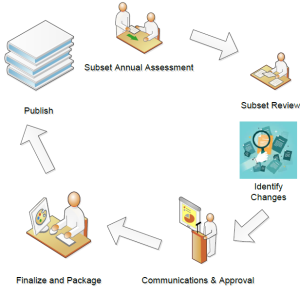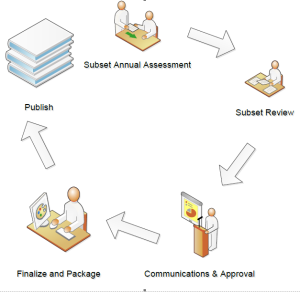What
...
are Subsets?
A subset is a set of members all of which are members of another set (from set theory in mathematics), but generally, in clinical terminologies, it is a set of concepts or terms taken from a larger set of terms or concepts.
...
Two subsets HealthCareProviderRoleType and QualifiedRoleType use the SC code systems (SCPQUAL, SCPTYPE) (the "SC Code Systems") which was a code system developed by Canada Health Infoway Inc. (Infoway) to address local requirements in Canada. SC was an abbreviation for "Standards Collaborative"
The subset maintenance for pan Canadian subsets is a two-year process
- In the first year, the subset will be inactivated (Depreciated) if not used in the previous year and no objections are received to an announcement is made on the Health Terminologies and HL7 forums. It will still be published on the Terminology Gateway, but not visible unless the ‘Inactive’ subset status is specifically chosen. If we do not receive a response to the request for a status of a subset after 30 Days, we will mark it for inactivation after 30 days and inactivate it.
- At the end of the first year, if the subset is still no longer in use, it will be marked as retired and no longer available in the Terminology Gateway
Additional Terminology Subsets
...
The subsets developed are vendor-neutral, they support interoperability and decrease the cost of creating and maintaining a new subset.
The subset maintenance for Additional Terminology Content is also a two-year process
- Jurisdictions and organizations are accountable for the quality and maintenance of subsets or other artifacts shared on the Terminology Gateway
- Each year, the Infoway SME will contact the subset owner named for the subset listed on the Terminology Gateway
- The contact will be asked to review their respective subset and asked if this is all good. If it is still good, then the reviewed date is updated. If there are changes then the Subset owner will make the changes to the subset and submit them. . If we do not receive a response to our request for a status of a subset, we will mark it for inactivation after 30 days
Where to find the Subset Template
...
- Download the subset Template from InfoRMS Subset RFC project.
- Complete the Subset Definition template. Refer to the "How to Complete" tab for guidance or contact [email protected] for assistance.
- All Field in Red are mandatory and must be completed
- Refer to the Naming Convention for pan-Canadian Reference Sets and Valuesets to create a name for the subset definition
- Request the Subset ID which is an OID, but if you are the owner of the Subset, you may provide your own unique identifier.
- Ensure that the Subset name and ID is not used in used by checking the OID's for subsets
- If the subsets is owned by you ( Additional Terminology Content) then a logo an be added which must be a .png or .gif which should be attached to the Subset request
- Select the Codesystem(s) (SNOMED CT, LOINC, UCUM, HL7,) You may have more than one to cover a clinical domain in some cases and if you need further guidance, contact standards@infoway-inforoute.ca
- Submit in InfoRMS for Review.
How to Change a subsets
- Download the subset from the Terminology Gateway in Excel format
- Update the fields in the downloaded file with the new information on the Subset Definition Tab.
- An update can be done to achieve the following: Add a new code, modify a term or a code and inactivate a term or a code.
- Overwrite an existing concept for a change
- Delete the line for a concept to remove from the subset these will be removed from the new version
- Add a line in the subset to add a new code. If a new code is required then follow the "Request New concepts" (AP)
- If Changes are made to the display names, the terminology Gateway will provide you with a Change Log, which should reflect all changes applied to the subset.
- It may be required to validate the status of all other codes and terms in the subset before re-publishing if the terminology has been updated since the last release.
- If the changes were only on the Concept Tab, change the «Subset version» to reflect the date of publication
- If the terminology versions have changed, update the «Terminology version» field.
- If the change is to the Subset name or Subset ID (OIDS), which is always unique to each subset contact the Standards HL7 OIDS resource at [email protected]
- Select the Update Subset as the issue type and complete the mandatory fields identified with an asterisk "*".
- Attach the completed Subset RFC template.
- Once the subset is updated and finalized, it will be loaded to the UAT environment of the Terminology Gateway for QA
How to Retire a subsets
- Download the subset from the Terminology Gateway in Excel format
- Create a new Subset RFC by selecting the «Create» button
- Fill in the UI information and attach the Batch template
- Complete the mandatory fields for the Requestor in InfoRMS
- Add a comment on the Subset RFC, the subset will be deprecated in one (1) year from now.
- When the one year is reached, add a comment on the RFC this subset is now Deprecated.
- Use the Infoscribe page to identify the Inactivated subsets that will be deprecated the following year.
- After one year ask IMT will remove the subset from the database
Quality Assurance (QA)
QA check covers the subset's metadata information and the terminology values, which include the correctness of concepts selected and the appropriate representation of the components as per the subset's template
- For pan Canadian Subset which is found in the Terminology Gateway in under the Subsets , the section. The QA is done by the Subset SME only and the standards team. It does not involve an any external stakeholder.
- Under the "Additional Terminology Content " section Subsets in the Terminology Gateway . Susbets that are involves require the Subset owner , checking to validate the contents, in the UAT environment of the Terminology Gateway.
- Subset owners will need to be provided access to UAT for QA purposes.
- The Subset owner will check the subset loaded in the Terminology Gateway UAT environment
- (see Staging ribbon in yellow in bottom right) correctly and represents the request. Any errors must be logged in the InfoRMS Ticket and commented. A corrected template must be attached to the InfoRMS ticker and loaded in QA UAT.
- Once QA is complete in the UAT. sign off in InfoRMS is required before it will be promoted to the Production environment.
- The subset owner will check the subset has been correctly loaded in TG Prod and sign off in the InfoRMS (Release form).
Naming Convention for pan-Canadian Reference Sets and ValueSets
...

